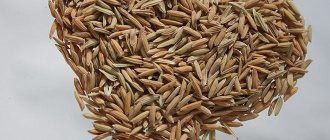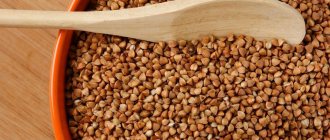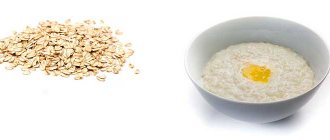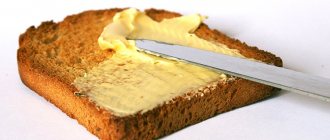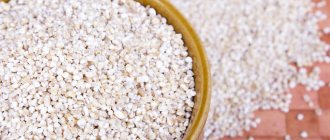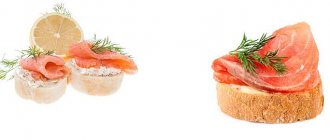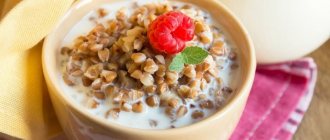Buckwheat is the most commonly used cereal due to its beneficial properties and high nutritional value. The last factor is directly related to calorie content, which varies depending on the method of preparation of the dish. Despite the fact that this figure is high, this product is in demand in weight loss diets. Thanks to slow carbohydrates and easily digestible proteins, buckwheat quickly and for a long time fills you up and energizes you.
Along with this, the body heals. Due to its great benefits and minimum contraindications, cereal is recommended for consumption by people of any age and condition.
- Buckwheat diet
- Casserole
Chemical composition
The composition of buckwheat is represented by a huge amount of vitamins and other very useful substances that help improve the functioning of almost all systems in the body. This doesn't only apply to adults. Dishes from the river will also be useful during gestation, and directly for children starting from 5-6 months from birth.
| Main components | Minerals |
|
|
The table below shows exactly what beneficial substances are contained in plain buckwheat. Based on this, it becomes clear why it is considered such a useful product.
Additional Information
The most gentle option for the body is not boiled cereal, but steeped cereal overnight in boiling water. The calorie content of the dish will increase if you cook it with milk. But here you need to take into account the characteristics of a particular type of milk, or more precisely, its fat content. For mono and any other diets, it is better not to use whole milk. The total nutritional value of 100 g of porridge cooked on it varies from 340 to 360 kcal.
For mono-diets, it is useful to use meat broth for cooking buckwheat. Many people like this version of the dish. Its nutritional value (even with added salt) ranges from 105 to 115 kcal. The final figure is determined by the cooking technology and the steepness of salting. If you add 12 g of butter to this amount of porridge, the energy value will rise to 155 kcal. This level can hardly be considered rational for those on a diet.
There is another recipe. It involves preparing 150 g portions of cereal. For 1 serving, 100 ml of water, 12 g of butter and 10 g of granulated sugar will be consumed. The total nutritional value of 100 g will be approximately 120 kcal, while the fat content is approximately 5 g, and the protein content is 2.5 g. It is worth considering that the calorie content of porridge with added butter is calculated for a creamy product with a nutritional value of 660 kcal. If it is different, then recalculation of the indicators will be required.
Fears regarding the excessive nutritional value of buckwheat porridge with butter are for the most part not justified. The whole point is how this nutritional value is achieved. The concentration of unsaturated fats significantly exceeds the proportion of their saturated “brothers,” which increases the ease of circulation in the body. Still, it is worth exercising reasonable caution, even if there are no chronic diseases or excessive body weight.
The best option is when the dish contains no milk, no vegetable or animal oil, no vegetables or meat additives. The optimal solution is simply tasty porridge cooked in water.
See the following video about the calorie content and benefits of buckwheat.
Calorie content of buckwheat boiled with butter
It should be said that the calorie content of buckwheat directly depends on the variety, but in addition, it should be noted that the number of calories can also vary due to additional components. For example, if you cook buckwheat:
- on water it turns out 90 kcal;
- when adding salt, the calorie content can increase by another 15 units;
- adding vegetable oil, kilocalories increase to 150 kcal;
- if you prepare boiled buckwheat with butter , then the calorie content per 100 grams will be 170 kcal.
It also needs to be said that when cooking buckwheat in milk, kilocalories can vary from 118 to 160 kcal. These values depend on the fat content of the milk used. For those who want to lose extra pounds, but still love milk, it is recommended to use a low-fat product. That is, buckwheat with butter has the highest calorie content.
This applies to both vegetable oil and butter.
Table of buckwheat BCJU (per 100 g of product)
Calorie content of buckwheat boiled in water with salt per 100 g. how to lose weight on buckwheat
The table below details how much protein is in boiled and raw buckwheat, as well as the exact amount of other important components in it.
| Boiled buckwheat | Raw buckwheat | |
| Squirrels | 3,6 | 12,6 |
| Fats | 2,2 | 3,3 |
| Carbohydrates | 17,1 | 57,1 |
| Cellulose | 1 | 11,3 |
| Water | 72,2 | 14 |
Calorie content of boiled buckwheat with butter per 100 grams
Oil added to the prepared dish softens the taste of porridge and makes it richer. In this case, the number of calories in boiled buckwheat increases. The exact nutritional value of porridge with butter depends on how the buckwheat is cooked (in water/milk), whether salt is added to it, and what kind of oil (sunflower/butter) in what quantity was added to the dish.
So, how many calories are in buckwheat cooked in the usual way? On average, in cereals seasoned with oil, the calorie level reaches from 140 to 160 kcal (per 100 g of product). An accurate calculation of nutritional value must be done independently.
To do this, you just need to add to the initial calorie content of the cereal (boiled without salt) the calorie content of the ingredients added to it.
How many calories are in buckwheat steamed with boiling water without salt?
The main dish of several diets at once is buckwheat steamed with boiling water. In this case, such porridge is prepared, as a rule, without salt. In such a pure form, the beneficial components contained in the cereal are not reduced by half (as happens during conventional cooking).
A special advantage of this method of preparation is the type (consistency) of the porridge. Buckwheat turns out crumbly and soft. It's quite simple to prepare:
- Rinse the buckwheat;
- Pour cold water over the cereal for 2-3 hours;
- Drain;
- Pour boiled water over the buckwheat (there should be 2 times more water);
- Place the container with the cereal in a warm place and/or cover it with a towel;
- Leave the buckwheat to steep overnight.
In the morning, buckwheat prepared in this way can be heated in the microwave or on the stove and immediately started eating. Those who are interested in the answer to the question of how many calories are in steamed buckwheat without salt will be pleasantly surprised. On average, the calorie content of such a product does not exceed 105 kcal (per 100 g).
Calorie content of boiled buckwheat without salt per 100 grams
The main difference between boiled and steamed buckwheat is the amount of useful components. At the same time, the calorie content of the resulting dish is almost identical.
So, buckwheat boiled without salt contains from 90 to 105 kcal (their exact amount depends on the specific type of cereal).
Calorie content of buckwheat with milk per 100 grams
Buckwheat with milk, of course, will have a nutritional value that is an order of magnitude higher than its lean counterpart. The exact number of calories in such buckwheat depends on the fat content and composition of the milk itself.
Therefore, the value of a dish should be calculated during its immediate preparation (taking into account information about the calories in milk and its amount added to the porridge).
On average, the calorie content in one serving of buckwheat with milk varies from 150 kcal to 175 kcal.
Properties of boiled buckwheat with butter
Everyone knows that buckwheat is considered very healthy, but it should be noted why it is useful and whether the indicated grain has contraindications must definitely be indicated.
Benefit
Buckwheat porridge is not only tasty, but also healthy. It is recommended to eat it directly not only because it contains a very large amount of useful microelements. Buckwheat should also be used as a preventive measure for diseases such as:
- Atherosclerosis – in this case, the process of removing cholesterol from the body occurs.
- Diabetes mellitus type 1 and 2. Allows you to reduce blood sugar levels.
- Gastritis. Recommended for use as part of a therapeutic diet.
- Osteoporosis. Provides the opportunity to strengthen bone tissue with the necessary microelements, for example, calcium, magnesium and zinc.
- Pancreatitis. It should be used as a therapeutic diet immediately 5-6 days after the onset of an exacerbation of the disease. Buckwheat is cooked exclusively without sugar, salt and oil in water with the addition of milk in a 1:1 ratio.
Buckwheat can also be consumed by people who suffer from rheumatic diseases, inflammation of the joints and those who have pathologies of the cardiovascular system or intestinal disorders. In addition, the buckwheat diet, used for weight loss, has proven itself well.
It is important to know! The greatest benefit of buckwheat is found in light-colored grains. If the grain is darker in color, this indicates that the grains were subject to significant heat treatment, and accordingly there are fewer useful substances left in it.
Harm and contraindications for use
Despite the usefulness of the designated product, there are also contraindications. For example, there are people who have individual intolerance. This is due to the fact that cereal contains a fairly large amount of protein. It is also not recommended to consume buckwheat for people suffering from:
- low blood pressure;
- diabetes mellitus;
- diseases affecting the gastrointestinal tract.
It should also be said that quite a lot of people use sprouted buckwheat as food, but this type of product is contraindicated for those who have high blood clotting. In addition, it is necessary to indicate that overeating is also fraught with side effects. They may be:
- disruption of the digestive process;
- allergic reactions may occur;
- there is a possibility of diarrhea or constipation;
- Severe headache may occur.
Quite often, people who consume buckwheat in large quantities suffer from severe fatigue and feel very overworked. Once again, we need to remind you that if a person has a disease such as diabetes, then you need to eat buckwheat dishes with extreme caution.
It is important to know! Buckwheat is a product that is capable of absorbing not only all odors, but also toxic substances from the environment.
Therefore, it is necessary to store buckwheat directly in tightly closed containers.
Peculiarities
Buckwheat with mushrooms and onions
Boiled buckwheat porridge with water has a minimal amount of calories and does not contain even small amounts of gluten. Therefore, it is great for anyone who suffers from contact with gluten. It is quite acceptable to use this dish for early complementary feeding of children. Buckwheat porridge contains many vitamins and minerals, valuable amino acids.
It is recommended to use:
- those suffering from anemia;
- pregnant women;
- people with a distorted balance of water and salt;
- those who want to organize proper nutrition.
The chemical composition of buckwheat is well balanced. This product can be safely recommended to those who have high blood sugar concentrations - it will soon decrease. With regular consumption of buckwheat, there is a decrease in joint pain and an improvement in skin diseases. Hair, teeth, nails look better. It remains to be seen how exactly buckwheat with butter can change the overall nutritional value of the diet.
How to cook buckwheat with butter
In cooking, there are many different recipes for preparing buckwheat. But you should know how to prepare it correctly in order to preserve the maximum amount of nutrients in it.
Boiled buckwheat porridge
Initially, it should be noted that to obtain crumbly buckwheat porridge, you need to pour boiling water over it before starting cooking. If you pour cold water over the cereal, you will get a more viscous consistency of the finished dish. Cooking time should be approximately 15-20 minutes. But it is worth considering that you need to cook buckwheat directly over low heat.
It is also necessary to indicate that it is necessary to take into account that the ratio of water and buckwheat should be 2:1. That is, 2 glasses of water for 1 glass of buckwheat. To add flavor to the finished buckwheat, you can add the following products:
- salt, pepper to taste;
- onions fried in vegetable oil;
- meat;
- mushrooms and even hard cheese.
You can also cook dishes from boiled buckwheat with butter simply in water , but do not forget that in this case its calorie content .
With milk
The basis for preparing buckwheat porridge directly is completely similar to the previous described recipe. As for adding milk, it can be poured into the plate after, that is, into the finished porridge.
I would like to note that if you use homemade milk, it is recommended to boil it first. If you use store-bought milk that has been pasteurized, then boiling it is not required.
Steamed
The simplest option for preparing buckwheat porridge directly is to steam it. To do this, you need to rinse the cereal well and place it in a saucepan or in a special cast-iron cauldron and pour boiling water over it.
Then you should wrap the kitchen utensils with steamed buckwheat in a thick towel or other similar material and leave it to steam. It is best to cook buckwheat overnight. This way the cereal will steam well, and in the morning the resulting porridge can be heated directly in the oil.
Dietary recipes
Buckwheat can be prepared in different ways, all recipes are simple, with an affordable set of products.
Dietary interpretations involve combination with mushrooms, vegetables, herbs, and lean meat. For breakfast, they usually make milk porridge, replacing sugar with honey. It is undesirable to put a lot of butter, which significantly increases the calorie content. Diabetics are usually prescribed to mix porridge with kefir.
Casserole
Ingredients:
- buckwheat - 100 g;
- kefir - 100 ml;
- carrots - 1 pc.;
- chicken egg - 1 pc.;
- prunes - 3-4 pcs.;
- salt and spices - to taste.
Preparation:
- Pre-boil buckwheat and carrots.
- Mix the egg and kefir using a blender.
- Add dried fruits, cereals and grated carrots.
- Mix everything thoroughly and add some salt.
- Transfer to a heat-resistant form greased with olive oil.
- Bake at a temperature of +190°C for about half an hour.
Buckwheat soup
A light and nutritious soup that requires:
- chicken fillet (beef or veal) - 350–400 g;
- onion - 1 head;
- carrots - 1 pc.;
- celery - 1 stalk;
- buckwheat - 100 g;
- potatoes - 2–3 pcs.;
- vegetable oil - 20 ml;
- salt - to taste.
Cooking method:
- The meat is boiled in lightly salted water, which is then removed and cut into small pieces.
- Fry chopped carrots and onions in oil for 5 minutes.
- Add diced potatoes and cereal to the boiling broth.
- After 10–15 minutes, add the frying.
- 3-4 minutes before turning off, add chopped celery.
Taste and add salt if necessary.
Cutlets
Required grocery set:
- buckwheat - 100–130 g;
- water - 200 ml;
- onion - 1 head;
- egg - 1 pc.;
- flour - 1 tbsp. l.;
- unrefined vegetable oil - 25–30 ml;
- salt, pepper - to taste.
Further actions:
- First, cook the cereal and grind it in a blender.
- Finely chop the onion and add it to the general composition.
- Mix flour, salt, spices and egg into the minced meat.
- Form cutlets and fry on both sides.
Porridge with vegetables
Components:
- buckwheat - 200 g;
- sweet peppers, tomatoes, carrots, zucchini - 1 pc.;
- greens, celery - 50 g;
- onion - 1 pc.;
- salt - to taste.
Process:
- The cereal is cooked until half cooked.
- Chop the onions and carrots as finely as possible and sauté in a small amount of oil for a couple of minutes.
- Then add the remaining chopped vegetables.
- After 5 minutes, transfer the buckwheat porridge into the frying pan.
- Chop the greens and sprinkle them on top.
- Mix thoroughly, cover with a lid and leave for another 7-10 minutes.
How and how much you can use
Considering that buckwheat is a very healthy product, it cannot be used as a permanent product. In addition, depending on the age category, cooked porridge per day is limited to a certain amount of grams.
Pregnant
Pregnant women, as well as those breastfeeding their babies, are recommended to eat buckwheat porridge directly, unless, of course, they are allergic to this product. This is due to the fact that the indicated cereal contains not only many useful micro and macroelements, but also quite a lot of protein.
In addition, buckwheat should be present in the diet of every pregnant woman, since it helps increase hemoglobin in the blood, thereby increasing the supply of oxygen for the normal development of the unborn child. But this does not mean that the designated product should be the main one in the diet.
As for the quantity, it can be consumed taking into account personal preference, that is, as much as the stomach allows, but at the same time it should be present in the diet no more than 1-2 times a week. Although, if the body requires more of the designated cereal, then you can eat it every day, but in small portions.
It is important to know! Eating buckwheat porridge during pregnancy allows a woman to eliminate the risk of anemia. In addition, thanks to the designated product, the occurrence of hypoxia of the developing fetus in the womb can be avoided.
At what age can children be given
Regarding the question of using buckwheat for children, it can be introduced into complementary foods for children who are already 4-6 months old. But it should be noted that initially you need to consult directly with a pediatrician.
According to experts, as a first complementary food, small children can be given initially no more than 0.5-1 teaspoon, for example, before meals. If this is a baby, then buckwheat puree mixture can be given before breastfeeding.
It should also be noted that in the absence of any negative manifestations after eating buckwheat for children, you can increase the serving size every day. That is, over the course of 7-10 days it is possible to increase the portion of buckwheat porridge to the age norm, namely up to 120-15 grams per day.
When losing weight
One of the effective ways to get rid of extra pounds is the use of a buckwheat diet. It is this type of diet that helps you lose about 6-7 kilograms in 7-10 days. But it should be said that it is not recommended to extend the indicated period, since it can cause harm to the body.
This is due to the fact that only one product is used during the diet, and this risks the body lacking other beneficial substances. It is better to go on a buckwheat diet again after some time, that is, use it periodically.
It should be noted that this diet involves consuming buckwheat porridge directly, which is prepared using the steaming method without adding other ingredients, including salt and sugar. As for the amount of buckwheat consumed per day, if a pure buckwheat diet (buckwheat and water) is used, the amount can be limited only by personal preference.
In the case of using other products, it is necessary to use no more than 150-250 grams per day. But it should be noted that the marked value refers to a dry product, and not to already prepared porridge.
In conclusion, it must be noted that buckwheat porridge has a beneficial effect on the body of any person, since it saturates it with all the necessary nutrients. It is also necessary to say that if there are no contraindications to its use, then this product can be consumed daily, the main thing is not to overdo it.
Table of buckwheat BCJU (per 100 g of product)
The table below details how much protein is in boiled and raw buckwheat, as well as the exact amount of other important components in it.
| Boiled buckwheat | Raw buckwheat | |
| Squirrels | 3,6 | 12,6 |
| Fats | 2,2 | 3,3 |
| Carbohydrates | 17,1 | 57,1 |
| Cellulose | 1 | 11,3 |
| Water | 72,2 | 14 |
Calorie content of boiled buckwheat with butter per 100 grams
Oil added to the prepared dish softens the taste of porridge and makes it richer. In this case, the number of calories in boiled buckwheat increases. The exact nutritional value of porridge with butter depends on how the buckwheat is cooked (in water/milk), whether salt is added to it, and what kind of oil (sunflower/butter) in what quantity was added to the dish.
So, how many calories are in buckwheat cooked in the usual way? On average, in cereals seasoned with oil, the calorie level reaches from 140 to 160 kcal (per 100 g of product). An accurate calculation of nutritional value must be done independently.
To do this, you just need to add to the initial calorie content of the cereal (boiled without salt) the calorie content of the ingredients added to it.
How many calories are in buckwheat steamed with boiling water without salt?
The main dish of several diets at once is buckwheat steamed with boiling water. In this case, such porridge is prepared, as a rule, without salt. In such a pure form, the beneficial components contained in the cereal are not reduced by half (as happens during conventional cooking).
A special advantage of this method of preparation is the type (consistency) of the porridge. Buckwheat turns out crumbly and soft. It's quite simple to prepare:
- Rinse the buckwheat;
- Pour cold water over the cereal for 2-3 hours;
- Drain;
- Pour boiled water over the buckwheat (there should be 2 times more water);
- Place the container with the cereal in a warm place and/or cover it with a towel;
- Leave the buckwheat to steep overnight.
In the morning, buckwheat prepared in this way can be heated in the microwave or on the stove and immediately started eating. Those who are interested in the answer to the question of how many calories are in steamed buckwheat without salt will be pleasantly surprised. On average, the calorie content of such a product does not exceed 105 kcal (per 100 g).
Calorie content of boiled buckwheat without salt per 100 grams
The main difference between boiled and steamed buckwheat is the amount of useful components. At the same time, the calorie content of the resulting dish is almost identical.
So, buckwheat boiled without salt contains from 90 to 105 kcal (their exact amount depends on the specific type of cereal).
Calorie content of buckwheat with milk per 100 grams
Buckwheat with milk, of course, will have a nutritional value that is an order of magnitude higher than its lean counterpart. The exact number of calories in such buckwheat depends on the fat content and composition of the milk itself.
Therefore, the value of a dish should be calculated during its immediate preparation (taking into account information about the calories in milk and its amount added to the porridge).
On average, the calorie content in one serving of buckwheat with milk varies from 150 kcal to 175 kcal.
